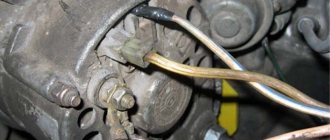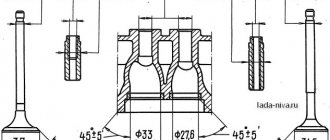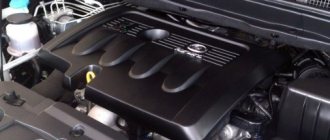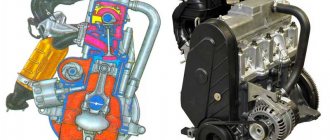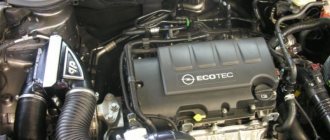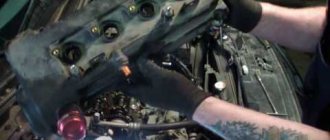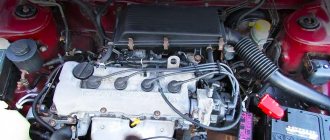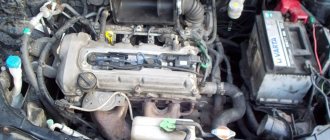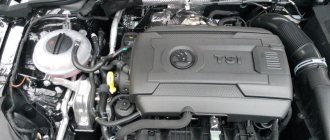Characteristics of motor 21214
It is believed that the basis of the ICE 21214 was the previous version 21213. In fact, ¾ of the parts in the engine
- the engine layout has changed - an injector instead of a carburetor;
- additional attachments appeared - DPKV, DXX sensor, Bosch MP 7.0 controller;
- crankshaft with a long crank radius of 40 mm, not used in previous AvtoVAZ engines;
- Cylinder head with holes for phase sensor and receiver studs, hydraulic supports for valve levers instead of adjusting bolts.
Hydraulic supports
Since the base model bends the valve, the 21214 engine did not escape this fate, so the manual includes not only a description of the engines, but also maintenance regulations in order to ensure at least the minimum declared service life of 80,000 km, which was promised by the manufacturer’s representatives.
Cylinder head 21214
The design of the power drive 21214 provides it with the following technical characteristics:
| Manufacturer | AvtoVAZ |
| Engine brand | 21214 |
| Years of production | 1994 – … |
| Volume | 1690 cm3 (1.7 l) |
| Power | 59.5 kW (81 hp) |
| Torque moment | 127.5 Nm (at 4000 rpm) |
| Weight | 122 kg |
| Compression ratio | 9,3 |
| Nutrition | injector |
| Motor type | in-line |
| Injection | distributed electronically controlled |
| Ignition | modular |
| Number of cylinders | 4 |
| Location of the first cylinder | TVE |
| Number of valves on each cylinder | 2 |
| Cylinder head material | aluminum alloy |
| Intake manifold | duralumin |
| An exhaust manifold | cast iron or welded steel |
| Camshaft | original cam profile |
| Cylinder block material | cast iron |
| Cylinder diameter | 82 mm |
| Pistons | from 21213 |
| Crankshaft | from 21213 |
| Piston stroke | 80 mm |
| Fuel | AI-92 |
| Environmental standards | Euro-2/3 |
| Fuel consumption | highway – 8.3 l/100 km combined cycle 10.5 l/100 km city – 11.5 l/100 km |
| Oil consumption | maximum 0.7 l/1000 km |
| What kind of oil to pour into the engine by viscosity | 5W30, 5W40, 10W40, 15W40 |
| Which engine oil is best by manufacturer | Liqui Moly, LukOil, Rosneft, Mannol, Mobil |
| Oil for 21214 according to composition | synthetics, semi-synthetics, mineral |
| Engine oil volume | 3.75 l |
| Operating temperature | 95° |
| ICE resource | declared 80,000 km actual 160,000 km |
| Adjustment of valves | hydraulic compensators |
| Cooling system | forced, antifreeze |
| Coolant volume | 7.8 l |
| water pump | with plastic impeller |
| Candles for 21214 | BCPR6ES from NGK or domestic AU17DVRM |
| Spark plug gap | 1.1 mm |
| Timing drive | single row chain |
| Cylinder operating order | 1-3-4-2 |
| Air filter | Nitto, Knecht, Fram, WIX, Hengst |
| Oil filter | with check valve |
| Flywheel | from 21213 with clutch bore diameter 200 mm or 215 mm |
| Flywheel mounting bolts | M12x1.25 mm, length 26 mm |
| Valve stem seals | manufacturer Goetze, light inlets, dark exhausts |
| Compression | from 12 bar, difference in adjacent cylinders maximum 1 bar |
| XX speed | 800 – 850 min-1 |
| Tightening force of threaded connections | spark plug – 31 – 39 Nm flywheel – 62 – 87 Nm clutch bolt – 19 – 30 Nm bearing cap – 68 – 84 Nm (main) and 43 – 53 (rod) cylinder head – three stages 20 Nm, 69 – 85 Nm + 90° + 90° |
With the advent of hydraulic thermal valve lash compensators, it is recommended to use exclusively high-quality engine oil.
Conclusion
VAZ 2121 engines are reliable, but have a short mileage before major repairs. Although, on the other hand, it is quite simple and quick to overhaul Niva power units, they are not picky about spare parts, and their cost is quite low.
Hello everyone! Today we’ll talk, strange as it may seem, about fields. More precisely, about two specific cars. 1- This is a VAZ 21219 (modification of a VAZ 2121) and 2- a VAZ 2130 Nadezhda! So let's start with the history of these cars. in order to introduce people who are not very close to VAZ SUVs!
And so for starters, VAZ 2121 NIVA!
VAZ 2121 Niva is a super popular SUV from AvtoVAZ, created on the basis of the VAZ 2106. The engine remains the 1.6L six, but with cosmetic modifications. Subsequently, on its basis, a 213 1.7-liter engine and a 2130 1.8-liter engine were created. The 214 injection engine was also used. In parallel with the Niva 2121, a Chevrolet Niva with a slightly modified 213 engine was also produced; technically and structurally, this car is very close to the regular VAZ 21213.
Also, at one time, on the basis of the VAZ 21214, at the OPP, a minivan with all-wheel drive was produced - Lada Nadezhda. The engine was from 2106. VAZ 2106 1.6 liter engine. continuation of the triple engine and, in turn, the penny motor. The main differences between the VAZ 2106 engine and the 2103 are the piston has an increased diameter to 79 mm; the engine block of the 2106 remains the same.
By the way, on the left side of it, to the left of the fuel pump, there is a place where the engine number 2106 is stamped, many cannot find it, this information will solve your problem once and for all. There is also an injector engine 21067, it is a regular six-wheel engine covered with a cylinder head from the injector Niva engine 21214, in fact, all the differences.
As time and practice have shown, a six-cylinder carburetor engine is more stable than an injection engine. The 2106 engine itself is an injection or carburetor inline 4-cylinder with an overhead camshaft, the 2106 timing belt has a chain drive. The motor belongs to the so-called “classic” series with a high block.
And also interesting: Off-road wheels for the Niva: review, photos -
The service life of the engine, with careful operation and timely maintenance, exceeds the 125 thousand km established by the factory and reaches 180-200 thousand km. Despite this, this engine is popularly considered less reliable than the engine from 2103. In order for the engine to live happily ever after, it must be warmed up before driving.
VAZ-21219 is a transitional combined modification with a body and suspension from the VAZ-2121 and a 1.7-liter engine and transmission from the VAZ-21213. The interior and rear window washer reservoir were also retained from the VAZ-2121. It was produced in 1993-1994. The engine was installed: VAZ 21213 1.7 liter engine. carburetor/injection(21214)
in-line 4-cylinder with overhead camshaft, Niva timing belt has a chain drive. Based on the 214 engine, the VAZ 2123 engine is produced for the Chevy Niva; the differences in adapting the block for installing a pulley in the engine compartment and mounting attachments are technically almost identical.
The main differences between the VAZ 21213 engine and the 2106 are the cylinder diameter is 82 mm, the cylinder head, the Niva 21213 engine block from the 2106 is smaller in height. Among the advantages of the 213 engine, it is worth noting the presence of a chain tensioner (no need to tighten it) and hydraulic compensators (no need to adjust the valves).
And finally, VAZ 2120 Nadezhda
VAZ 2120 Nadezhda is a minivan from AvtoVAZ with all-wheel drive. It was developed on the basis of the Niva 2121 and differed little from it structurally. Serial production of the car was never established, the reason for this was the inflated price, general low quality and, accordingly, lack of consumer interest. The base engine of the VAZ 2120 was the Nivov 2130 1.8 liter engine.
Along with it, a 21214 1.7i injection engine was also installed. The VAZ 2130 1.8 liter engine. carburetor/injection in-line 4-cylinder with overhead camshaft, timing belt 2130 has a chain drive. The engine belongs to the so-called “classic” series with a high block. Compared to the Niva block 21213, the VAZ 2130 engine block is 1.3 mm higher, thanks to this it became possible to install a crankshaft with a piston stroke of 84 mm and obtain a volume of 1.8 liters.
The VAZ 2130 engine knocks, heats up, and troits like a classic one, and all the problems of sixes and sevens are here too. In addition, engines have the problem of increased camshaft wear, as well as the need for regular (every 7-10 thousand km) adjustment of valve clearances, this is indicated by a loud knocking sound when the engine is idling, which can be heard from the driver’s seat with the hood closed.
So why did I start this whole topic! Recently, a man came up to my car and began to inspect the car and asked a bunch of questions about modifications. The questions were banal. What kind of tires, who the manufacturer is, how it performs in the mud, how it does on asphalt, how it makes noise, what kind of lift, what is the consumption with modifications and all that sort of thing... Then he asked about the engine. I answered that the carburetor 1.7 was bored out to 1.8, in total there is a 213 engine from 21219.
Next, a question was asked for the shaft! Of course, it is native, an ordinary Niva-val. Then he asked why he didn’t put it from Nadezhda? And then it changed for me. Initially, I thought that Nadezhda was powered by ordinary engines from the 06 Lada, or from the Niva 21213 and 21214. As it turned out, this is not the case! Hope has its own engine. This can be clearly seen from the ha-kams of the engines!
Engine VAZ 2106 / 2121 / 21074Characteristics of the VAZ 2106 engine
Engine VAZ 1.6 l. Years of production - (1976 - present time) Cylinder block material - cast iron Power system - carburetor/injector Type - in-line Number of cylinders - 4 Valves per cylinder - 2 Piston stroke - 80 mm Cylinder diameter - 79 mm Compression ratio - 8.5 Engine displacement 2106 - 1569 cm3
Engine power 2106 – 75 hp. /5400 rpm Torque - 116 Nm / 3000 rpm Fuel - AI92 Fuel consumption - city 10.3 l. | track 7.4 l. | mixed 10l/100 km Oil consumption - 700 g per 1000 km Overall dimensions of engine 2106 (LxWxH), mm - 565x541x665 Weight of engine 2106 - 121 kg Oil in engine 2106: 5W-305W-4010W-4015W-40 How much oil is in engine 2106: 3.75 l. When replacing, fill about 3.5 l.
Also interesting: RUN-IN OF A Chevrolet Niva CAR
VAZ 2106 engine life: 1. According to the plant – 125 thousand km2. In practice – up to 200 thousand km
TUNING Potential – 200 hp. Without loss of resource – 80 hp.
The engine was installed on: VAZ 2106 VAZ 2121 Niva VAZ 21074
Engine VAZ 21213 / 21214 / 21219 NivaCharacteristics of the Niva engine
Years of production – (1994 – present time) Cylinder block material – cast iron Power system – carburetor (21213) / injector (21214) Type – in-line Number of cylinders – 4 Valves per cylinder – 2 Piston stroke – 80 mm Cylinder diameter – 82 mm Compression ratio – 9.4 Engine displacement Niva 21213 – 1690 cm3
Engine power Niva 21213 – 81 hp. /5200 rpm Torque - 125 Nm / 3000 rpm Fuel - AI93 Fuel consumption - city 11.5 l. | track 8.3 l. | mixed 10.5 l/100 km Oil consumption - 700 g per 1000 km Niva engine weight - 117 kg Overall dimensions of the Niva engine 21213 (LxWxH)
Niva engine life: 1. According to the plant – 80 thousand km2. In practice – up to 150 thousand km
TUNING Potential – 200 hp. Without loss of resource – 90 hp.
The engine was installed on: VAZ 21219 Niva VAZ 21213 Niva VAZ 21214 Niva Chevrolet Niva
Engine VAZ 2130 Niva Nadezhda 1.8 Engine 2130 characteristics
Years of production – (1993 – present time) Cylinder block material – cast iron Power system – carburetor/injector Type – in-line Number of cylinders – 4 Valves per cylinder – 2 Piston stroke – 84 mm Cylinder diameter – 82 mm Compression ratio – 9.4 Engine volume – 1774 cm3 Power 2130 – 82 hp /5200 rev.
minTorque – 139 Nm/3200 rpm Fuel – AI93 Fuel consumption – city 16.5 l. | track 9.7 l. | mixed 12.1 l/100 km Oil consumption - 700 g per 1000 km Weight of the VAZ 2130 engine - 122 kg Geometric dimensions of the VAZ 2130 engine (LxWxH), mm - 560x350x710 Oil in the VAZ 2130 engine: 5W-305W-4010W-4015W-40 How much oil is in the engine 2130: 3.75 l. When replacing, fill in about 3.5 liters. up to risks MAX
Resource 2130:1. According to the plant – 80 thousand km2. In practice – 150-180 thousand km
TUNING Potential – 200 hp. Without loss of resource – 80 hp.
The engine was installed on: VAZ 2120 “Nadezhda” VAZ 2121 “Niva”
Now the question is tormenting me! Is it worth the hassle and installing a Nadezhda shaft on Nivov engines? After all, they put Niva-shafts on penny, triple and six-ruble coins, and there is a result! Or maybe it’s worth replacing the engine altogether with one of the three 2120 engines? I'm interested in whether anyone has installed a shaft from hope in their original engine, or whether they even replaced original motors from 2106 or 21213 with engines from hope?
If changed, what changes in the behavior of the car. (behavior of the car in the city, on the highway, in off-road conditions) The engines of interest are 2120 1.8, 2120 1.7i, 2120m 1.7i. I cannot compare the behavior of Nadezhda and a simple Niva, because the cars have different weights, dimensions, and aerodynamics (which is a specific indicator of the car’s behavior on the track) I’m waiting for your answers and feedback)
Read news about the new Niva
- The modernized Lada Niva Legend (4x4) 2021 was shown on the Internet
- Lada 4×4 Bronto - sales stopped, new details » Lada.Online - all the most interesting and useful about LADA cars
- Description of the instrument panel Lada 4×4 (VAZ 2121, 2131) » Lada.Online - all the most interesting and useful about LADA cars
- Chevrolet Niva gasoline consumption per 100 km
- Buy LADA (VAZ) 2131 (4×4) 2021 in Rostov-on-Don, low price for Lada 2131 (4×4) 2021 on the Avto.ru website
- Fuses Niva 21214 injector «
- The new large Lada 4×4 Niva “Bigster” 2021-2022 based on the Dacia Bigster was shown for the first time. The SUV has changed beyond recognition
- New Niva Chevrolet Lux 2021 - review of GLC equipment
Design Features
Initially, the 21214 engine was developed for distributed injection, that is, for an injector. It was planned to ensure an environmentally friendly standard, which was carried out successfully - during the finalization process, the internal combustion engines had Euro-2 - Euro-4, and for the export versions of Niva and Nadezhda, even Euro-5.
The main feature of 21214 was the factory boost:
- injector instead of carburetor;
- modified cylinder head (hydraulic pushers);
Hydraulic support ramp (bottom)
In turn, this required improvement of other designs:
- the volume of engine oil has increased, the pump sprocket now has 30 teeth to increase its performance;
- the double-row chain is replaced by a roller-type single-row modification to drive attachments and the timing camshaft;
- The camshaft cams have changed shape.
Design 21214
Upgraded chain tension system:
- the spring creates pre-tension when the engine is off;
- After starting, pressure is created in the system, the tension is regulated by hydraulics.
Hydromechanical chain tensioner
The manufacturer has provided additional do-it-yourself tuning due to the +50 hp potential built into the design. With. Overhauling the simplest internal combustion engine design does not cause any problems, including in a garage on your own.
Bosch 0280158110 injectors were first installed on the fuel rail, then yellow Siemens VAZ 20734. The ignition has a modular design with Bosch MP 7.9.7 and January 7.2 controllers. Pair-parallel injection provides Euro-2, phased injection – Euro-3.
Description of the motor device
In terms of geometry, the VAZ 21214 engine is identical to its predecessor - the thirteenth model. Experienced mechanics may notice small changes in the design of an internal combustion engine. For example, the size and shape of the lid have changed. Since engineers installed a crankshaft position sensor in the engine.
Attention! The 21214 engine from the VAZ company has a special hole for installing a bracket to which the power steering pump will be attached.
Some models, as described above, differ in the manifold alloy - cast iron and welded steel. The latest manifold was created for engines with Euro 3 environmental class. Thus, the weight of the motor was reduced. The neutralizer warms up faster. The temperature can be kept at a certain level necessary for optimal operation of the collector.
And the crankshaft pulley is supplemented with a timing disc. The cylinder head is equipped with additional holes. They are intended for mounting the phase sensor.
Instead of adjusting bolts, engineers installed hydraulic supports. A lubricant is supplied to them. Thus, we got rid of the constant adjustment of the thermal clearances of the valves. The fuel rail is made of stainless steel.
The operating order of the cylinders is as follows: 1, 3, 4. The timing drive is equipped with a single-row chain with a hydraulic tensioner. Now this chain does not need to be constantly tightened. The oil pump sprockets have only thirty teeth.
Initially, injectors from Bosch were installed on the fuel rail. Then we switched to installing Siemens VAZ 20734. They differ from the first ones in color - yellow. Phased fuel injection sets environmental standards such as Euro 3, while parallel injection sets Euro 2.
The engine is equipped with a fuel injector and an idle speed sensor. The diameter of the cylinders is 82 mm. The torque in operating mode is 127 Nm, but the engineers have included a reserve for tuning the power unit. An experienced car owner will be able to increase engine power by 50 horses during tuning.
Similar article VAZ 11186 engine, technical characteristics and service life
Major repairs are not difficult. It can be carried out in a garage, the main thing is to understand the device and understand the design of the power unit.
It is recommended to change the oil and oil filter device every 10 thousand kilometers; under difficult operating conditions, these periods should be reduced to five thousand. The candles last for sixty thousand kilometers. The battery will last the same amount of time if it is not used in northern regions. But the cabin filter is updated annually, regardless of the vehicle’s mileage.
Advantages and disadvantages
The specified engine characteristics and its design have disadvantages:
- high noise during operation;
- very low service life;
- significant vibrations on the machine body;
- overheating of the engine in the urban cycle;
- high engine oil consumption.
As a result, frequent major repairs and an increased operating budget. The main advantages were:
- automatic chain tensioner;
- valve lifters;
All the problems of the classic series remain, however, with timely maintenance, the engine does not cause any special problems for the owner.
Common internal combustion engine problems
Why are there so many negative reviews about this internal combustion engine model 21214:
- strong oil burner. Intensifies with engine aging. Occurs due to carbon deposits on the cylinders. Not only does oil consumption increase, but the car also begins to consume fuel in large quantities;
- elevated temperature. The thermostat often fails, so the temperature cannot stabilize in the engine. Most often, overheating also occurs due to a clogged cooling radiator. Therefore, experienced mechanics advise checking the cooling system and cleaning it annually. This is especially necessary if the machine with this motor is used in difficult operating conditions;
- The motor itself is noisy. The engine noise increases even more when the following elements break: pumps, hydraulic compensators, main and connecting rod bearings. Experienced mechanics recommend immediately contacting a service center if noise occurs. Since, if the connecting rod bearings become unusable, the entire engine will need major repairs;
- low service life. Car owners note that the service life is one hundred and fifty thousand kilometers. Despite the fact that engineers claim 300 thousand kilometers, the engine does not cover that much. Although there have been cases when, with proper care, the engine can cover this mileage.
Similar article Volume, power and cost of the Toyota Camry engine
The advantage of the engine is that it can run on any type of gasoline: AI 92 or AI95. It makes no difference to the engine what kind of fuel it consumes. However, the car owner will constantly have to monitor the level of lubricant inside the engine, which tends to quickly decrease.
Another advantage is the oil seal that is installed on the water pump. It has a high lifespan and does not crumble from the first strong overheat. Experienced mechanics also have the advantage of hydraulic valve lifters and an automatic chain tensioner. These elements have a high lifespan and can outlive the engine itself, with proper care, of course.
What cars was it used in?
Motor 21214 was used to equip several cars manufactured by AvtoVAZ:
- Lada Niva 4x4 (VAZ-21214) – three-door SUV;
- Lada 4x4 M - modernized version with power steering and ABS;
- Lada 4x4 5D (VAZ-213100) – an extended modification of a five-door SUV;
- “Ambulance” (VAZ-213145) – Euro-2/3 in small series;
- Lada Nadezhda (VAZ-2120) is a seven-seater all-wheel drive minivan.
Niva Lynx 4x4
The management did not consider it necessary to install it on the seven-seater Largus minivan. But in all modifications of the Niva 3- and 5-door (Bronto, Kedr, Pickup, Reka, Bys and armored collection vehicle) it was present.
Modifications
Since 1994, the manufacturer has adjusted the parameters of motor 21214 several times:
- 21214-10 (2002) – Euro-0, the first version had central gasoline injection;
- 21214-20 (2006) – Euro-2 controller Bosch MP 7.0, pairwise variable injection;
- 21214-30 (2008) – Euro-3, without power steering;
- 21214-41 (2011) – Euro-4 for the Russian Federation and Euro-5 for export, power steering, welded manifold;
- 21214-22 – Euro-2, hydraulic supports for valve levers appeared;
- 21214-31 – Euro-3, welded steel manifold, power steering pump;
- 21214-32 – Euro-3, power steering, cast iron manifold, flywheel for 215 mm clutch diameter;
- 21214-33 – Euro-3, cast iron manifold, hydraulic booster;
- 21214-34 – Euro-3, cast manifold without power steering.
All versions from the factory had INA hydraulic mounts, with the exception of version 21214-41, which was equipped with YAZTA hydraulic mounts.
Power steering 21214
Modification 21214-28 had a volume of 1.8 liters due to the larger piston stroke of 84 mm. The engine power reached 92 hp. s., and the torque is 159 Nm. In total, a little more than 69 engines of this type were produced.
Maintenance
The manufacturer AvtoVAZ recommends servicing the 21214 engine on your own or at a service station according to the following schedule:
- the oil and filter are updated annually or after 7.5 - 10 thousand mileage;
- the chain has a high resource of 200 thousand, but is regularly monitored for stretching/tension;
- the fuel and air filters become unusable after 20 - 30 thousand mileage;
- spark plugs and batteries are usually enough for 60 - 70 thousand km;
- It is recommended to update the cabin filter annually, regardless of the car's mileage.
Initially, the internal combustion engine design was simpler, but it was necessary to periodically adjust the erroneous settings of the valve thermal clearances. Then the modernization added hydraulic pushers to the timing belt design, saving the user from this operation and monthly expenses.
Malfunctions, causes, elimination
Initially, engine 21214 has a characteristic failure - failure of 1 - 2 cylinders due to failure of the ignition module due to overheating. The coils and control switch burn out, and electrical equipment needs to be replaced. Other breakdowns are typical for most VAZ engines:
| At idle, the internal combustion engine is unstable and stalls. | 1) damage to the insulation of high-voltage wires 2) spark plug malfunction 3) valve timing failure 4) compression decreased | 1)replacement of high-voltage beams 2)adjusting the interelectrode gap, cleaning carbon deposits 3) installation according to shaft marks 4) valve grinding, cylinder repair |
| XX speed decreased spontaneously | 1) production of DXX | 1) replacing the idle speed sensor |
| The engine stalls while driving in the heat | 1) check valve stuck 2) the hose or tube is pinched 3) the drain line has failed 4) steam plug in the supply system | 1) valve replacement 2) inspection and correction of geometry 3) purging the line 4) purge and cleaning |
Hydraulic compensators eliminate the need for scheduled adjustment of valve clearances after 5–15 thousand kilometers.
Fuel and drain line
Tuning
The manufacturer used only one technique to increase engine power - increasing the piston stroke. Self-tuning will help you modify the 21214 engine to use its full potential (about 90 hp):
- boring of cylinders in the block - scheme 84/84 or 84/88 to obtain 1.9 liters and 2.0 liters (cylinder diameter/piston stroke, respectively);
- modification of the cylinder head - boring of channels up to 31 mm (exhaust) and 33 mm (intake), installation of a lightweight SHPG flywheel, Nuzhdin camshaft.
Thus, the injection version 21214 is superior to the basic modification of the carburetor engine. It has increased torque and power, and bends the valves with pistons when the single-row chain wears out.
If you have any questions, leave them in the comments below the article. We or our visitors will be happy to answer them
Price of a new and contract engine
The price of an injection engine on the secondary market starts from 20,000 rubles. The new ICE 21214 costs 86 thousand rubles. Although experienced mechanics say that by purchasing a contract engine, the car owner will not go wrong.
Before selling a contract engine, it is checked by experienced mechanics. Only original parts are installed on it. A guarantee is given.
